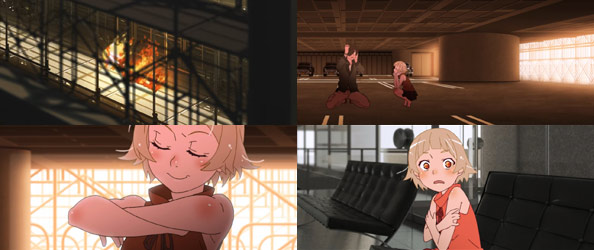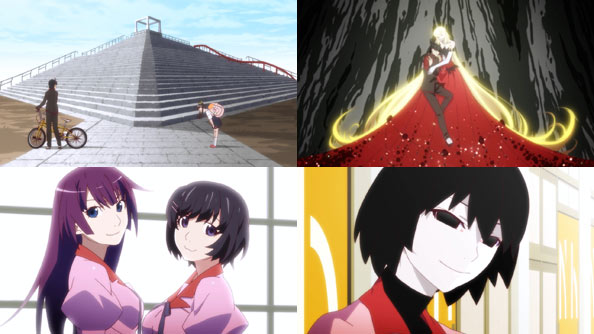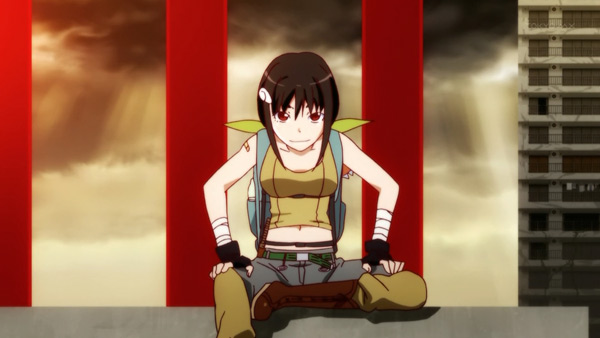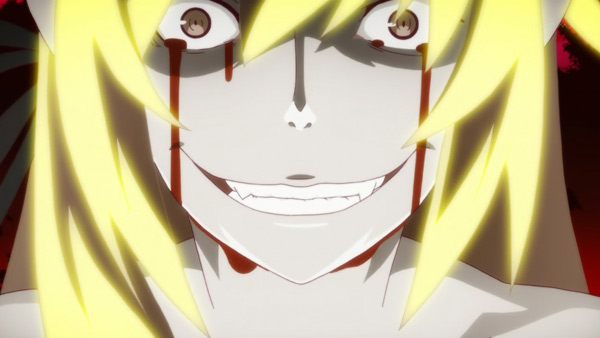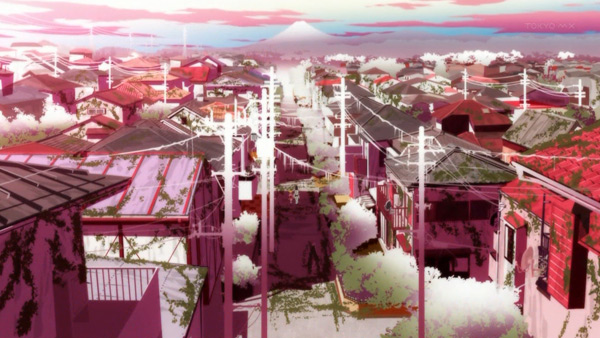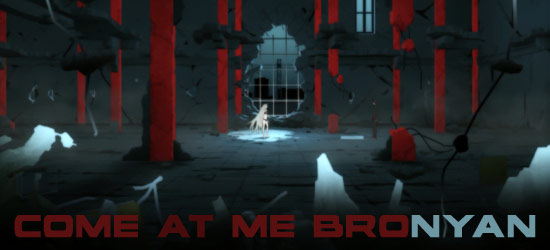Araragi Koyomi has beaten Dramaturgy, Episode, and Guillotinecutter with relative ease, and secured his master Kiss-Shot’s four extremities.
This third movie isn’t about that mission; that’s over now. It’s about everything that comes after, and how we get to Kiss-Shot being at full power to the greatly diminished state in which we were introduced to her in 2009’s Bakemonogatari.
Kiss-Shot promised Koyomi she’d make him a human if he got her arms and legs back, and while Oshino was meant to be Koyomi’s fourth opponent—he in possession of Kiss-Shot’s heart—he is satisfied that the balance has been restored. He not only surrenders the heart, but forgives Koyomi’s 5 million in debt before taking off.
So, will Kiss-Shot keep up her end of the bargain she struck with Koyomi? She’s certainly happy to be in her 26-year-old form; giddy, even. They meet on the roof of the cram school and talk simply like two old chums.
Kiss-Shot tells Koyomi about her first servant, whom she lost to suicide (she tells him more about this during Onimonogatari), and pulls Kokoro-watari, a memento from that time, out of her body.
After watching Kiss-Shot frolick on the roof, Koyomi realizes he’s a bit hungry, so volunteers to pick up some snacks at the local 7-Eleven while Kiss-Shot ‘prepares’ to restore his humanity.
Upon his return, he discovers the nature of that preparation: Kiss-Shot graphically devouring Guillotinecutter, then wondering where Koyomi’s “mobile snack”, i.e. Hanekawa is.
It’s a devastating revelation to Koyomi that yeah, when Kiss-Shot is talking about food she’s talking about humans. She feeds on humans, and he not only saved her life, but restored her to full power. As he rages in the gym equipment room, blaming himself for Guillotinecutter’s death, Hanekawa pays him a visit.
As far as Koyomi’s concerned, he doesn’t deserve to get his humanity back after everything he’s done. He doesn’t even deserve to live, and certainly doesn’t want to live to the point where he sees Tsubasa as food. He’s already disgusted with the fact that the three hunters he defeated were on the side of justice.
Tsubasa, not surprisingly, has his back when he doesn’t have his own. She’s made her selfishness known to Koyomi, and she wants to see him next term, so he can’t die. Besides, throwing away all he’s accomplished thus far would just be running away. Even if he eats her, she’s fine with it, because she wouldn’t call someone a friend unless she’s willing to die for them, no matter the reason.
No, pointing the blame on and killing himself isn’t the right path for Koyomi. Not when he’s the only one who has a chance against a Full Power Kiss-Shot. Knowing he has to go up against her, Koyomi asks, for the first time ever, if he can touch Tsubasa’s boobs, in order to “build up his tolerance” for Kiss-Shot’s own substantial bust.
That attempt goes bust, however, when Tsubasa is more than willing to let him fondle her boobs and even take her maidenhood if he likes, but he chickens out and instead gives her a weak shoulder massage.
Hitagi may end up being Koyomi’s beloved, but there can be no doubt who his best friend is after watching these movies. Because all this takes place before he even meets Hitagi, Tsubasa is free to be the one and only girl, and thus one hell of a best one.
Alright, no more fooling around, it’s time to fight his master Kiss-Shot, who makes one hell of a fiery, explosive entrance in the stadium, the venue of their duel. Kiss-Shot know realizes she was insensitive in being so casual about how she took her meal. With that in mind, she asks him to return to her side, but of course he can’t, because she ate someone.
Koyomi saved her life, and won back her limbs, because she was weak. Once she was no longer weak, and Koyomi saw what she was capable of, he essentially woke up from the spell he had been under. At an impasse, they begin to go at it.
Because they’re both immortal, quick-healing vampires, it’s an absolutely bonkers fight, with heads and limbs flying all over the place, oftentimes sprouting back up before the old parts faded away. But as bloody and brutal as it is, the fight is a stalemate, with neither party able to inflict lasting damage on the other.
Once again unable to stay away when her friend is in need, Tsubasa tells Koyomi something isn’t right, and it’s something everyone but Koyomi would have realize by now: Kiss-Shot wants to be killed; it’s the only way for Koyomi to get his humanity back.
When Kiss-Shot tries to lash out at the interfering Tsubasa, Koyomi (or rather, his head and some neckbones) latch on to Kiss-Shot’s neck, and he starts sucking her blood, a lot of it, until fully half of it is gone, leaving her shriveled and powerless.
But he doesn’t want Kiss-Shot to die.
Instead, he wants everyone to get what they want; everyone to be satisfied. So he calls out to Oshino, whom he knows is watching, and hires him (for five million) to come up with a solution. Unfortunately, no amount of money will change the fact that it’s impossible for everyone to be satisfied.
So instead, Oshino, true to his nature of attaining balance everywhere he can, proposes a way for everyone to be dissatisfied in equal measure. Kiss-Shot can live on as pseudo-vampire mimicking a human, robbed of all her power and dependent on Koyomi to survive.
Koyomi, meanwhile, will become a pseudo-human mimicking a vampire; and both will continue to live, and the risk to humanity will be greatly reduced, but not completely eliminated. Koyomi won’t let Kiss-Shot die, so he takes the deal.
Fast-forward to August and the beginning of a new term for Koyomi and Tsubasa. He still heals quickly for a human, but not nearly as quickly as he was. He also views the world differently now that he can walk in the sun again, something Tsubasa thinks is very positive.
Koyomi pays a visit to Oshino at the cram school to give what’s left of Kiss-Shot some of his blood. On the roof, Oshino characterizes the situation thusly:
What you remember of a vampire eating someone…is like the disillusionment of watching a cute cat devour a live mouse.
And here you are, having chosen to keep your own little vampire like a pet.
You’ve dulled its fangs, pulled out its claws, crushed its throat and neutered it, right?
You, who was once treated as a pet, are getting back at your former master by treating her as one…not a moving tale, is it?
Well, it was, and is, most definitely a moving tale, but I prefer Koyomi’s more poetic way of characterizing it:
We, who hurt each other so terribly, will sit here licking each others wounds. We damaged goods will seek the other out in comfort.
If you are to die tomorrow, I’m fine with my life ending then as well.
But if you want to live for me for one more day, I’ll go on living with you today as well.
And thus begins a tale of kindred bound by their scars.
Soaked in red and written in black, a story of blood.
One of which I’ll never speak.
Our very own, precious as it is, story of scars.
And I have no intention of reciting it to anyone.
It’s not just a beautiful way to end this fantastically epic prequel trilogy, but an artfully powerfully-stated mission statement for all of the stories in the Monogatari Series that follow chronologically. It’s inspired me to re-watch Nekomonogatari (Kuro) and then Bakemonogatari from the beginning, with a new appreciation for where Koyomi has been, and—thanks to the recently completed Owarimonogatari—where he’s going.
Finally, major kudos to Kamiya Hiroshi, Horie Yui, and Sakamoto Maaya; all three elevated these movies that much more with their layered, engaging performances.

























